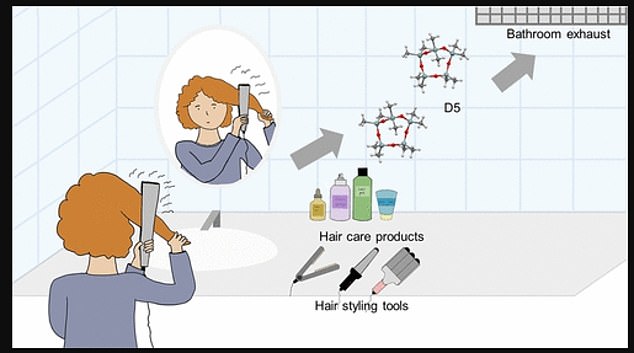
Hair products used everyday by millions of women in the US could be exposing them to a dangerous chemical linked to infertility, a study warns.
Siloxanes are man-made chemicals that are used in creams, oils and sprays to shine and smooth hair by preventing moisture from getting in or out.
Scientists from Purdue University in Indiana found that when used with high-heat from curling and straightening tools, the siloxane-laden hair products evaporate and release toxins into the air.
Siloxanes, derived from silicone, have been linked to fertility issues, hormonal imbalance, and liver damage.


Concentrations of volatile compounds in the air increased every time a product was applied to a section of hair. Adding products that emit high heat made those concentrations reach even higher


When met with temperatures of 210 degrees Celsius, researchers found the chemical emissions from the hair care products increased anywhere from 50 to more than 300 percent
They conducted a series of experiments that asked participants to recreate their haircare and styling routines in a tiny home meant to mimic the confined space in their bathrooms at home.
Using the products with and without heated tools drove up concentrations of a class of volatile chemicals called cyclic volatile methyl siloxanes (cVMS) in the air.
When the exhaust fan was turned off, concentrations of volatile chemicals in the air reached 82 milligrams per cubic meter, though switching on the fan cleared about 70 percent of the polluted air.
After 20 minutes, people inhaled a cumulative 17mg of siloxane.
Animal studies involving the class of chemicals have shown that much higher concentrations in the air reaching into the tens of thousands are fatal.
While the lethal dose in humans is less clear, researchers warned that repeated exposure to these chemicals as part of a daily routine can have downstream health effects.
Siloxanes are synthetic relatives of silicone ubiquitous in personal care products because that seal the hair or skin to prevent moisture from getting in or out, providing a superficial smoothness.
Each study participant was instructed to bring the products they use at home to the tiny house, including hair lotions, sprays, serums, and oils, as well as any hot tools they may use.
The products studied were primarily marketed toward women, though were technically unisex.
The chemicals have also been found in products geared toward men, too. A cream pomade made by Redken, for instance, contains a siloxane known as dimethicone.
The participants then separated their hair into four sections and tested different treatments on each.
Concentrations of volatile compounds in the air increased every time a product was applied to a section of hair.
Applying high heat of about 210 degrees Celsius to hair coated in these products exacerbated the levels of harmful chemical emissions, increasing emissions anywhere from 50 to 310 percent.
Dr Nusrat Jung, lead author and a professor at Purdue’s School of Civil Engineering, said: ‘We found the results to be extremely alarming.
‘We did not expect to see such significant emissions of volatile chemical mixtures from off-the-shelf hair care products during typical hair care routines that many people perform each and every day.’
Siloxanes evaporate easily in the air to form a gas, a quality that scientists call volatility.
One example of another volatile organic compound that evaporates quickly is acetone, which explains the characteristic pungent smell of nail polish remover as it dries.
The chemical’s ability to evaporate quickly without leaving a sticky residue and its lubricating ability to prevent friction between hair strands have made it a staple ingredient in so many skin and hair products.
The most troubling chemical they identified is decamethylcyclopentasiloxane (aka D5 siloxane), which is often listed first or second in the ingredient lists of many hair care products, indicating it can be among the most abundant ingredients.
Dr Jung said: ‘D5 siloxane has been found to lead to adverse effects on the respiratory tract, liver and nervous system of laboratory animals.
‘The use of the chemical in wash-off cosmetic products has already been restricted in the European Union because of this. Many of these products are scented, too, and some of the chemicals used to make these fragrances are potentially dangerous to inhale as well.’
Another siloxane chemical called D4, which is considered to be long-lasting and toxic in the environment, is a known endocrine-disrupting chemical that has been shown in rat studies to behave similarly to estrogen.
The chemical was found to have increased the weight of the rodents’ uteruses and changed the height of of the cells lining tissues in their bodies, which can negatively affect the reproductive organs and contribute to the development of endocrine disorders. For instance, conditions like polycystic ovary syndrome (PCOS).
On average, a person could inhale a total mass of one to 17 milligrams of potentially harmful chemicals in a single 20-minute hairstyling session.
Switching on the exhaust fan successfully reduces levels of D5 in the air by about 70 percent, and keeping the fan on ‘accelerates the decay’ of the compound in the air.
With the exhaust fan on, the D5 concentration drops by 95 percent to less than one milligram per cubic meter within 20 minutes after completing the hair care routine.
While helpful for clearing out the bathroom or, in this case, the tiny home, researchers cautioned that exhaust fans divert that contaminated air to the outside world, contaminating more space than just one’s own home.
Dr Jung said: ‘Home ventilation is likely a major pathway of indoor-to-outdoor siloxane transport.
‘In urban environments, this is especially significant as you will have hundreds — even thousands — of homes ventilating out potentially harmful chemicals into the urban atmosphere all in a short span of time as people get ready for work and school in the morning.’
The chemicals then find their way back into buildings through ventilation systems, Dr Jung added.
‘So even if using products with harmful chemicals is not part of your hair care routine, you will still be impacted due to your surroundings in an urban environment.’
Their findings were published in the journal Environmental Science & Technology.
This post first appeared on Dailymail.co.uk








